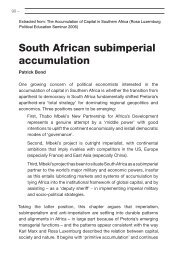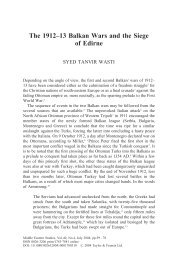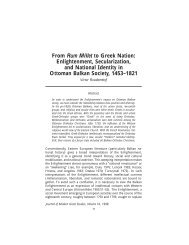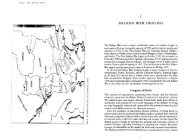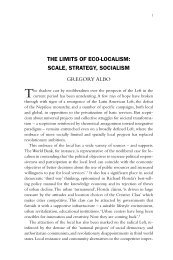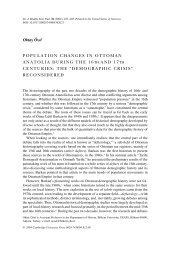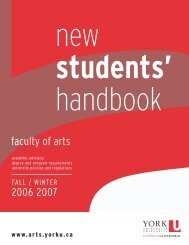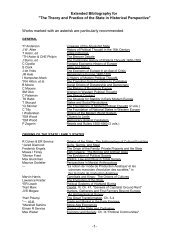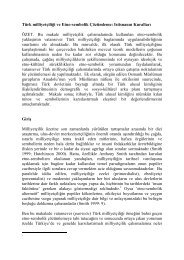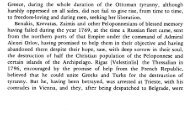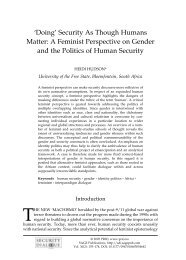FYCSG 05/06 REV2 - Faculty of Arts - York University
FYCSG 05/06 REV2 - Faculty of Arts - York University
FYCSG 05/06 REV2 - Faculty of Arts - York University
Create successful ePaper yourself
Turn your PDF publications into a flip-book with our unique Google optimized e-Paper software.
SC/EATS1010 3.0 The Dynamic Earth and Space Geodesy. An overview <strong>of</strong> modern<br />
geophysics: origin <strong>of</strong> the Earth, impact cratering, internal structure and rheology,<br />
earthquakes, plate tectonics, geomagnetism. Space geodetic positioning techniques<br />
such as VLBI, SLR and GPS are introduced as means <strong>of</strong> detecting and monitoring<br />
tectonic movements. One term. Three credits.<br />
Prerequisites: One <strong>of</strong> OAC Calculus, OAC Algebra and Geometry, 12U Advanced Functions<br />
and Introductory Calculus, 12U Geometry and Discrete Mathematics, or<br />
AS/SC/MATH1515 3.0; OAC Physics or 12U Physics or SC/PHYS1510 4.0.<br />
Degree credit exclusion: SC/EATS1010 6.0.<br />
SC/EATS1011 3.0 Introduction to Atmospheric Science. The origin, composition and<br />
vertical structure <strong>of</strong> the Earth’s atmosphere and those <strong>of</strong> other planets. The present<br />
global atmospheric circulation. Weather systems, measurements and weather maps;<br />
atmospheric chemistry: the ozone layer and atmospheric pollution. Three lecture hours<br />
per week, five three-hour laboratory sessions. One term. Three credits.<br />
Prerequisites: OAC Calculus, OAC Algebra and Geometry, 12U Advanced Functions and<br />
Introductory Calculus, Geometry and Discrete Mathematics or AS/SC/MATH1515 3.0;<br />
OAC Physics or 12U Physics or SC/PHYS1510 4.0<br />
Degree credit exclusion: SC/EATS1010 6.0.<br />
SC/PHYS1010 6.0 Physics. Topics include linear, rotational and oscillatory motion;<br />
Newtonian mechanics; electrostatics; magnetostatics; electric current and induction;<br />
heat; geometrical and physical optics and sound. Differential and integral calculus<br />
and vector algebra are used. This course covers fewer topics than SC/PHYS1410 6.0,<br />
but covers them in greater depth. It should be taken by all those likely to enrol in<br />
2000-level PHYS courses. Three lecture hours per week in the first term, two lecture<br />
hours per week in the second term; three laboratory hours in alternate weeks in both<br />
terms; one tutorial hour each week in both terms.<br />
Prerequisite: OAC Physics or 12U Physics or SC/PHYS1510 4.0.<br />
Corequisites: SC/PHYS1019 0.0, AS/SC/MATH1013 3.0 and AS/SC/MATH1014 3.0<br />
and AS/SC/MATH1025 3.0, or AS/SC/MATH15<strong>05</strong> 6.0, or equivalents.<br />
Degree credit exclusion: SC/PHYS1410 6.0.<br />
SC/PHYS1070 3.0 Astronomy. An introduction to astronomy for science majors. The<br />
course gives an overview <strong>of</strong> basic astronomical knowledge from the solar system to<br />
the edge <strong>of</strong> the Milky Way and basic astronomical concepts from white dwarfs to<br />
black holes.<br />
Prerequisite: OAC Physics or 12U Physics or SC/PHYS1510 4.0.<br />
Prerequisite or Corequisite: AS/SC/MATH1013 3.0 or AS/SC/MATH15<strong>05</strong> 6.0 or<br />
equivalent.<br />
SC/PHYS1410 6.0 Physical Science. Topics include kinematics, dynamics, momentum<br />
and energy for linear and rotational motion; elementary kinetic theory and thermodynamics;<br />
static and current electricity; waves and physical and geometrical optics,<br />
elements <strong>of</strong> modern physics. Recommended for students unlikely to enrol in 2000-level<br />
PHYS courses. Three lecture hours per week in the first term, two lecture hours per<br />
week in the second term; three laboratory hours in alternate weeks in both terms; one<br />
tutorial hour each week in both terms.<br />
Prerequisite: OAC Physics or 12U Physics or SC/PHYS1510 4.0. This is a calculus-based<br />
course making use <strong>of</strong> elementary differential and integral calculus. While not mandatory,<br />
a first-year mathematics course involving calculus, such as AS/SC/MATH1013 3.0<br />
and AS/SC/MATH1014 3.0 or AS/SC/MATH15<strong>05</strong> 6.0, is normally taken concurently.<br />
Co-registration in AS/SC/MATH1515 3.0 or AS/SC/MATH15<strong>05</strong> 6.0 is strongly<br />
recommended for students lacking OAC Calculus or 12U Advanced Functions and<br />
Introductory Calculus.<br />
Corequisite: SC/PHYS1419 0.0.<br />
Degree credit exclusion: SC/PHYS1010 6.0.<br />
SC/PHYS1510 4.0 Introduction to Physics. An introductory course for students lacking<br />
adequate preparation for SC/PHYS1010 6.0 or SC/PHYS1410 6.0. Topics involve<br />
Newton’s laws applied to linear and angular motion, force, inertia, torque, impulse,<br />
momentum, centre <strong>of</strong> mass, work, energy, oscillatory motion, geometric optics<br />
(including lenses and mirrors). No calculus is used, but vectors are used extensively.<br />
Three lecture hours per week, a laboratory session alternating weekly with a tutorial<br />
session. One term.<br />
Prerequisite: Ontario Grade 11 Functions and Relations (new curriculum) or Ontario<br />
Grade 12 Advanced Mathematics (old curriculum).<br />
Note: May not be taken by any student who has taken or is currently taking another<br />
university course in physics.<br />
32




